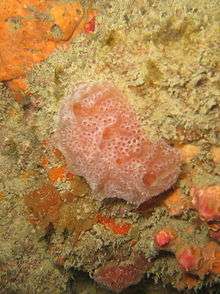Aplidium elegans
Aplidium elegans is a species of colonial sea squirts or sea strawberry, tunicates that is an benthic invertebrate part of the Polyclinidae family and Ascidiacea class.[2] It is native to shallow waters in the Atlantic Ocean and Mediterranean Sea.[2] It is also found in between France and the United Kingdom.[2]
| Aplidium elegans | |
|---|---|
 | |
| Aplidium elegans | |
| Scientific classification | |
| Kingdom: | Animalia |
| Phylum: | Chordata |
| Subphylum: | Tunicata |
| Class: | Ascidiacea |
| Order: | Enterogona |
| Family: | Polyclinidae |
| Genus: | Aplidium |
| Species: | A. elegans |
| Binomial name | |
| Aplidium elegans (Giard, 1872)[1] | |
| Synonyms | |
| |
Description
Aplidium elegans form firm, flattened globular masses, that look like pink cushions from 3 to 4 cm long.[3] The color is striking, with large white papillae around the inhalant siphons of the zooids and deep pink coloration of the colony.[3] The arrangement of the zooids in the colony gives a meandering pattern, with cloacal canals between zooids.[3] The zooids are embedded in a common test and grouped around sinuous, irregular cloacal canals.[2] The oral siphons are slightly prominent and bordered of eight small white lobes.[2] Colonial ascidians, like other benthic invertebrates show great morphological variability in terms of shape, size and color in response to both genetic characteristics and local environmental conditions.[4]
Distribution and habitat
Aplidium elegans is found in the Atlantic Ocean, Mediterranean Sea, and the English Channel.[4] The colonies are found on rocks in waters 5 meters to 20 meters deep.[4] Also can be found on moderately exposed rocky sites, usually with moderate tidal streams, attached to rocks.[3] The colony is around 50mm broad and 15mm thick.[3]
Biology
Aplidium elegans colony is made up of a couple different parts.[4] The zooid is the individual animal, and in a colony, there are multiple zooids.[4] The colony has a test or tunica which is a thick layer secreted by the mantle, containing cellulose and protecting the animal.[4] Every zooid then has an oral siphon which is an opening by which water is drawn in the ascidian to collect nutrients.[4] Aplidium elegans must also have a cloacal which water is expelled from the ascidian.[4]
See also
References
- Giard, A. (1872). Recherches sur les Ascidies composées ou Synascidies. Archives de Zoologie Expérimentale et Générale. 1, pages 501-687, pls. 25-30
- Bay-Nouailhat A., September 2005, Description of Aplidium elegans, Available on line at http://www.european-marine-life.org/32/aplidium-elegans.php, consulted on 02 March 2019.
- Gabriele, M.; Bellot, A.; Gallotti, D.; Brunetti, R. (1999). Sublittoral hard substrate communities of the Northern Adriatic Sea. Cah. Biol. Mar. 40(1): 65-76
- Murugan R, Ananthan G., Arunkman A. (2018) Aplousobranchia ascidians in Andaman and Nicobar Islands: a combined morphological and molecular discrimination. Mitochondrial DNA Part A, 29, 879-884.